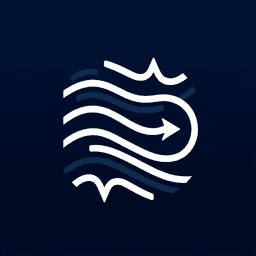
Currents Maps: Definition and Examples
February 27, 2025
Currents Maps
Currents maps are essential tools for sailors and maritime users, providing detailed information about the movement of water in the world's oceans and seas. These maps illustrate the direction and speed of ocean currents, which are critical for navigation, route planning, and safety at sea.
Importance for Sailors: Understanding ocean currents is vital for sailors as they can significantly impact a vessel's speed and fuel efficiency. By utilizing currents maps, sailors can optimize their routes to take advantage of favorable currents, reducing travel time and conserving fuel.
Components of Currents Maps: Currents maps typically include arrows indicating the direction of the current, with varying lengths or colors to represent the speed. Some maps may also provide information on water temperature and salinity, which can affect current patterns.
Types of Currents: Currents maps may display various types of currents, including surface currents driven by wind patterns, and deeper ocean currents influenced by differences in water density and temperature. Notable currents often featured on these maps include the Gulf Stream, Kuroshio Current, and the Antarctic Circumpolar Current.
Technological Integration: Modern currents maps are often integrated with GPS and other navigational systems, allowing for real-time updates and more precise navigation. This integration helps sailors make informed decisions based on the latest data.
In summary, currents maps are indispensable for maritime navigation, offering critical insights into ocean dynamics that can enhance safety and efficiency for sailors worldwide.
Understanding Currents Maps for Maritime Use
Currents maps are essential tools for maritime navigation, providing critical information about the movement of ocean water. These maps are used by mariners to understand and predict the behavior of ocean currents, which can significantly impact navigation and safety at sea.
What is the Meaning of Current in Maritime?
In maritime terms, a current refers to the horizontal movement of water from one location to another. This movement is driven by various factors, including the rise and fall of tides, wind, and thermohaline circulation. Currents are typically measured in meters per second or knots, with one knot equating to 1.85 kilometers per hour or 1.15 miles per hour.
What is Current in Navigation?
In navigation, currents are classified as either tidal or non-tidal. Tidal currents are caused by the gravitational interactions between the sun, moon, and earth, and are part of the general movement of the sea, which also includes tides. Understanding these currents is crucial for plotting courses and ensuring safe passage.
What is an Ocean Current Defined As?
An ocean current is defined as a continuous, predictable, directional movement of seawater. These currents are driven by gravity, wind (including the Coriolis Effect), and differences in water density. They play a vital role in regulating climate and supporting marine life.
What is the Difference Between a Wave and a Current?
Waves and currents are both movements of water, but they differ in their causes and effects. Waves are generated by wind and travel in all directions from the point of disturbance. In contrast, currents are the movement of water particles controlled by winds and density differences, and they can travel in specific directions, sometimes opposite to waves.
For maritime users, understanding these distinctions and the information provided by currents maps is crucial for effective navigation and safety at sea.




